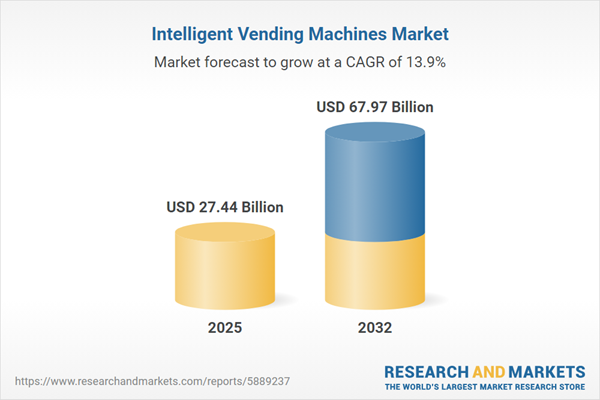Speak directly to the analyst to clarify any post sales queries you may have.
Intelligent vending machines are redefining enterprise retail automation, empowering organizations with integrated digital solutions that streamline operations and elevate customer experience. For senior decision-makers, these technologies enable agile adaptation and drive competitive value across evolving business landscapes.
Market Snapshot: Intelligent Vending Machines Market
The intelligent vending machines market is poised for significant expansion, with an industry value projected to grow from USD 24.03 billion in 2024 to USD 27.44 billion by 2025, ultimately reaching USD 67.97 billion by 2032. This growth represents a robust CAGR of 13.87%.
Rising enterprise demand for contactless retail and automated processes is accelerating adoption. Organizations are prioritizing seamless payment systems, remote device management, and centralized operational analytics to optimize workflows and enhance business process resilience in a competitive environment.Scope & Segmentation of the Intelligent Vending Machines Market
This research report offers senior leaders focused insights for investment planning and strategic adoption of intelligent vending machine solutions, addressing key segmentation and trends relevant to global deployment.
- Product Types: Automated vending options supply snacks, beverages, dairy, prepared foods, electronics, cosmetics, and sanitary goods, each designed for a range of business applications and user needs.
- Component Architecture: Advanced systems combine hardware—such as dispensing units, secure payment devices, refrigeration, and sensor suites—with enterprise-ready software for inventory control, real-time monitoring, and compliance management.
- End Users: Sectors spanning education, healthcare, corporate spaces, transport centers, and retail emphasize operational continuity, system reliability, and robust safeguards to drive efficiency and ensure business continuity.
- Distribution Channels: Enterprises deploy solutions through direct sales, value-added distributors, and e-procurement, tailoring implementations to specific organizational objectives and future growth.
- Regional Coverage: Asia-Pacific is advancing rapid adoption with urbanization and digital transformation, while the Americas and EMEA maintain a focus on infrastructure integration and strategic modernization to meet mature market demands.
- Industry Competitors: The competitive environment features providers such as Crane Co., Fuji Electric Co., Ltd., Azkoyen S.A., Sanden Holdings Corporation, Evoca Group S.p.A., USI Italy S.p.A., Seaga Manufacturing, Inc., Nayax Ltd., Zhejiang Weiye Machinery Co., Ltd., and Cantaloupe Systems, Inc., with ongoing innovation targeting enterprise automation.
Key Takeaways: Intelligent Vending Machines Market
- AI-driven features personalize product recommendations and adjust pricing dynamically, enabling enterprises to align offers with real-time user preferences.
- Integrated IoT functions support proactive device monitoring and predictive maintenance, which reduces service interruptions and increases operational stability.
- Biometric and contactless authentication strengthen the security bridge between physical and digital sales environments while supporting regulatory compliance in targeted sectors.
- Modular architectures simplify upgrades and regulatory alignment, supporting technical advancements and continuous service with minimal business disruption.
- Regional adoption dynamics reveal Asia-Pacific’s focus on digital-first retail, contrasted with North America and Europe’s priority on process reliability and data-intensive improvements.
- Collaboration among manufacturers, technology providers, and finance organizations accelerates the integration of advanced payment and asset management tools, facilitating rapid enterprise scaling.
Tariff Impact
Forthcoming U.S. tariffs on electronics are prompting enterprises to diversify sourcing strategies. Organizations are increasingly turning to modular vending architectures and collaborative procurement models to enhance flexibility, adapt to regulatory changes, and manage supply chain risks with greater agility.
Methodology & Data Sources
This report’s findings are developed through comprehensive secondary research, in-depth industry publication analysis, specialized expert consultation, and value chain evaluation. Data quality is assured by triangulation with scenario modeling, providing clear, credible guidance for strategic decisions.
Why This Intelligent Vending Machines Market Report Matters
- Enables senior leaders to identify emerging revenue opportunities and make informed investment decisions in retail automation and technology transformation.
- Supports risk mitigation and supply chain optimization, equipping organizations to navigate shifting market and regulatory demands.
- Facilitates adaptation of operational processes in alignment with ongoing changes in technology and consumer behavior.
Conclusion
Intelligent vending machines are central to next-generation retail automation. With focused insights, organizations can enhance efficiency, build resilience, and position themselves for ongoing commercial success.
Additional Product Information:
- Purchase of this report includes 1 year online access with quarterly updates.
- This report can be updated on request. Please contact our Customer Experience team using the Ask a Question widget on our website.
Table of Contents
3. Executive Summary
4. Market Overview
7. Cumulative Impact of Artificial Intelligence 2025
Companies Mentioned
The companies profiled in this Intelligent Vending Machines market report include:- Crane Co.
- Fuji Electric Co., Ltd.
- Azkoyen, S.A.
- Sanden Holdings Corporation
- Evoca Group S.p.A.
- USI Italy S.p.A.
- Seaga Manufacturing, Inc.
- Nayax Ltd.
- Zhejiang Weiye Machinery Co., Ltd.
- Cantaloupe Systems, Inc.
Table Information
| Report Attribute | Details |
|---|---|
| No. of Pages | 184 |
| Published | November 2025 |
| Forecast Period | 2025 - 2032 |
| Estimated Market Value ( USD | $ 27.44 Billion |
| Forecasted Market Value ( USD | $ 67.97 Billion |
| Compound Annual Growth Rate | 13.8% |
| Regions Covered | Global |
| No. of Companies Mentioned | 11 |









